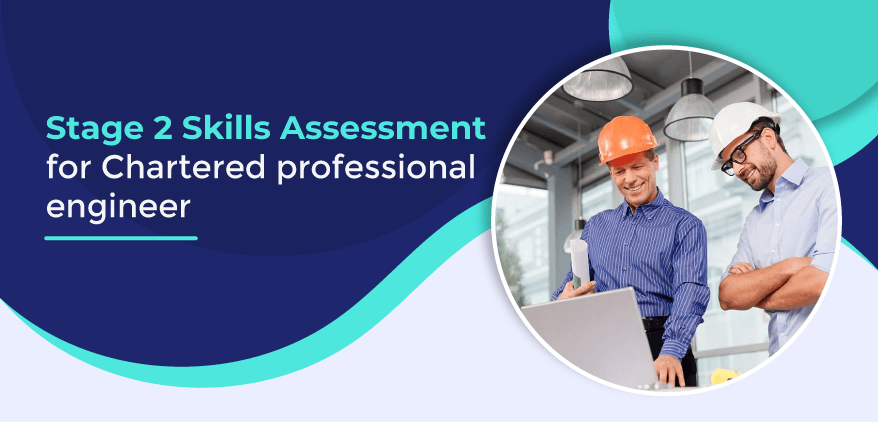Stage 2 Competency Claim Service for EA
Get expert assistance for the Stage 2 Competency Claim.
100% assurance for the positive Migration Skills Assessment from EA
Free Consultation
Get free consultation from experts!
STAGE 2 COMPETENCY CLAIM
Stage 2 Competency Claim Service

The candidate has to pass the competency standard stage 2 assessment to achieve the chartered status of a professional engineer. The experience, expertise, professional level of working practice, engineering ability, and optimistic attitudes of experts are reflected in the EA stage 2 competency claim.
Personal engineering competency is certified via the stage-2 competency assessments, often known as the charter standard. A Chartered Engineering professional achieve high-level competence via years of work. To be recognized as a charter engineer with Engineers Australia, engineers must demonstrate professional competency in leadership, knowledge, performance, and safety.
Several sage 2 competencies claims have been made by our experienced writers and specialists over the years. You have to submit your previously submitted CV plus CDR report if you want to apply for a Stage 2 competency claim.
It is vital to mention any additional experience you have after submitting your CDR in this document. In order to create more solid claims, you’ll be asked a few questions about your professional past if you haven’t previously.
What is Stage 2 Competency Standard?
Stage 2 Competency Standard is the certification of personal engineering competency. The skillset, level of knowledge, values, engineering application skills, and attributes of the profession must be shown in order to operate freely and unsupervised as an Engineering professional in Australia.
These standards are used to access candidates for EA’s Chartered Membership (CPEng) and registration on the National Engineering Register (NER). A chartered professional engineer is regarded as having attained the highest level of engineering expertise via experience. In the government, business, and the general public, this professional degree is well-known. Obtaining CPEng designation necessitates a lifelong commitment to maintaining a high degree of expertise in the discipline.
Four Units for Stage 2 Competency Claim
There are four units of stage 2 competency claim. Personal commitment, the obligation to the community, value in the workplace, and technical proficiency are among them.
The personal Commitment section requires you to demonstrate:
- How will you deal with any ethical issues raised
- How will you define and develop your areas of competence
- How will you show a personal sense of responsibility for your job
Depending on the type of work you conduct, the ‘community’ will change. It might be a client, regulatory agency, the general public, or your boss. This competency unit asks you to show that you can:
- Identify and manage the risks associated with the engineering activities
- Deliver safe and sustainable solutions
- Incorporation of legal and regulatory requirements into your solution
- Define the community and consider the community benefits at various stages of engineering activities (within the context of your work)
This unit of competency requires you to demonstrate how you:
- Work within an organization to provide value for stakeholders
- Collaborate and work with others
- Apply your professional judgment
- Initiate, plan, lead or manage and secure financial and other material resources to support engineering activities
This unit of competency requires you to demonstrate how you:
- Use advanced engineering science
- Make effective use of engineering knowledge provided by other people
- Analyze problems and develop creative and innovative solutions
- Evaluate the outcomes and impacts of engineering activities
Structure of the Stage 2 Standard
The stage 2 competency standard has two sections. The first one is: The competencies and the second one: The Standards
Part A: The Competencies
There are fourteen primary categories or units, three of which are basic units that apply to all fields of engineering practice and eleven optional units from which candidates select two that are relevant to their field of practice. Some of them are as follows:
- C1 Engineering Practice
- C2 Engineering Planning and Design
- C3 Self-Management in the Engineering Workplace
- E1A Engineering Business Management or
- E1B Engineering Project Management
- E2 Engineering Operations
- E3 Materials/Components/Systems
- E4A Environmental Management or
- E4B Investigation and Reporting
- E5 Research, Development and Commercialization
- E6 Sourcing and Estimating Materials
- E7 Change and Technical Development
- E8 Technical Sales and Promotion
- E9 Engineering Education
Each unit is made up of a number of components. Each element contains a set of actions, or quantifiable outputs, that specify how it should be shown. They’re referred to as defining activities. An element can be proven if the applicants have successfully completed most or all of the required actions.
Part B: The Standards
Each profession has its own set of criteria. The selection criteria are based on the job descriptions as professional engineers, engineering technologists, and engineering associates.
Professional engineers are in charge of engineering tasks. Risk management, issue solving, and ensuring that technical and non-technical concerns are properly incorporated are just a few of the critical tasks they do.
Technical project management is an issue for engineering technologists. They are typically experts in the theory and practice of certain engineering areas, as well as their application, adaption, and control in various situations.
Engineering associates double-check the application of known standards and norms of practice in both familiar and unusual situations. They assist in the execution of engineering projects or the management of engineering activities.
Intricacies of Stage 2 Competency Report
Engineers must first gather information and proof about their experience, projects handled, and other pertinent elements in order to write the appropriate stage 2 competency report. A passport-style photo, CV, a detailed explanation of each job title and corresponding roles/responsibilities, and other essential components are also required for the exam.
It’s not easy to create a flawless and professional-looking stage 2 competency claim. The report has to show the skills of the professional engineer. There are a lot of technical components for the stage 2 competency report. It will obviously be difficult to write it on your own. That is why expert assistance is recommended in order to write a report free of errors and plagiarism.
Hire Best CDR Writers
We are one of the popular CDR, RPL report, and KA02 report writing service providers in Australia. We provide high-quality CDR services to all applicants with the help of experts, a professional team of writers, IT specialists, engineers.
Our expert CDR writers have years of experience in writing plagiarism-free reports. Our experts can prepare customized reports for any specific engineering job or occupation. CDRAustraliaHelp provides online assistance to candidates all around the world. Contact us if you want to achieve positive skills assessments.
Our Services
Our Features
Many clients have received a positive approval. Hurry up and connect with us now!





